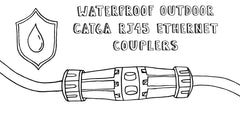Payment methods accepted

What Do All The Colors Mean? Fiber Optic Color Coding
Written by Ben Hamlitsch, trueCABLE Technical and Product Innovation Manager RCDD, FOI
We are surrounded by colors. Everything we look at has or is a specific color. We use those colors to identify things or even take certain actions. Colors are even used in enforcing laws. Think of a traffic light; you have red, yellow, and green. Each of these colors signify something very specific and we know based on these colors what they mean and what we are supposed to do.
There are six fundamental colors in the visible spectrum – These are red, orange, yellow, green, blue, and violet. When we see a rainbow, we are seeing these principal spectral colors and from these colors come all other colors that we see with our eyes. 
Like all things in life where we use color to identify and take action, we do the same with fiber optics. Fiber optic color coding is an important part of cable management. The TIA-598-D defines and promotes a standardized color-coding system as a way for engineers and technicians to work with and identify fiber optic cables and other components.
Fiber color codes are used to help identify fiber cables (including patch cables, premises cables, and outdoor cables), fiber connectors, and individual fibers. There are multiple benefits of using a fiber optic color coding system in both indoor and outdoor applications, including:
When fiber optic cables are correctly color-coded, it is much easier for installers to identify which cable goes where. This can save a lot of time and resources during the installation process, ultimately making for a more cost-effective project.
Once fiber optic cables are installed, they can be very difficult to access. This makes it important to have a color code system in place so that fiber technicians can easily identify which fiber needs to be repaired or replaced.
When fiber optic cables are color coded, it is much easier to select the strands to be spliced together. A splice tray may carry up to 72 fibers, meaning it would be chaos without a color tracking system. Put simply, tracking the different colors of the fibers, means engineers can ensure continuity throughout a cable run.
One of the biggest benefits of fiber optic color coding is that it can help to reduce human errors. This is because fiber technicians will be able to quickly and easily identify which fiber goes where, thus minimizing the risk of mistakes. Without color coding, it’s relatively easy for an engineer to mix up a 50/125 with a 62.5/125 multimode fiber. And of course, multi-fiber cables typically contain tens if not hundreds of individual strands.
In some cases, fiber optic cables must be separated into different ports. Color coding can help to make this process much simpler and more efficient.
How are fiber optic cables typically color coded?
The TIA-598 fiber optic cable color code standard is the most used method for color-coding fiber optic cables. This standard was developed by the Electronics Industries Alliance (EIA) and the Telecommunications Industry Association (TIA). The EIA has since been dropped and we now only use the TIA standards alliance.
TIA-598 is the standard fiber color code used in the United States, and the most recognized system worldwide. The method uses a combination of two different colors to identify each fiber. For example, the first fiber in a cable may be blue and the second fiber may be orange.
Which parts of the fiber optic cables are color coded? The fiber optic color code system is used to color the different parts of the fiber optic cable. These parts include:
- The outer cable jacket of the fiber optic cable
- The fiber optic connector
Cable jacket colors:
These are used to determine the fiber classifications, fiber numbers, and sizes of cables used in premises distribution cables, premises interconnect cables, interconnect cords, or premises breakout cables. In non-military applications, you can expect the following color coding for these types of fiber:

Inner Cable Organizational Fiber Color Code
Inside a multi-fiber cable, individual fibers are compliant to fiber color code as well. They are often distinguished from one another by color-coded jackets, buffers, or tubes on each fiber. According to TIA-598, inner fibers are color coded in a group of 12 fibers and they are counted in a clockwise direction.
For cables that consist of multiple buffer tubes each with 12 or less strands, each tube will be numbered or colored following the same fiber color code, e.g., 1st tube is blue, 2nd is orange, etc.
For cables that consist of more than 12 strands, the fiber optic cable color code repeats itself. Each group of 12 fibers is identified with some other means. For example, 24 strand groups are with the fiber color code repeating with some variation, e.g., the 1st group of 12 strands are solid colors and the 2nd group is a solid color with a stripe or some other identifying marks.

Connector Color Code
Connectors are also a part of the fiber color code. Since there are different polish styles of fiber end-face, the connectors of fiber jumpers and the mating adapters are color coded for identification. However, the advent of metallic connectors like the FC and ST made connector color coding difficult, so colored strain relief boots are also used. The boot color may vary among manufacturers.

Quick tip: How do you remember fiber optic color codes? Struggling to remember which color goes where? Here is a simple way to break down the fiber color code 12 fiber colors to easily remember them.

Fiber optic cable color code is a system that helps us distinguish fiber types visually from the colored fiber jacket, fiber connector, fiber boot, etc. The optical fiber color coding is also practical for fiber optic engineers during splicing because the colorful fibers also help ensure the continuity of color codes throughout a cable run. Thus, fiber cable color coding is essential to fiber optic communications like the twisted pair color coding to copper wiring systems.
Here are some FAQ's for fiber color code understanding.
-
What are the most common fiber optic color codes? The most common codes follow the TIA-598 standard.
-
Can I create my own color code system? While it's possible, it's recommended to follow the industry standards to avoid confusion.
-
What are the best tools for learning fiber optic color codes? Mnemonics, visualization techniques, and specialized tools like color code wheels can be highly effective.
-
How can I make sure to follow safety guidelines while dealing with fiber optic cables? Always adhere to your workplace's prescribed safety guidelines and regular training.
-
Is there any technology specifically designed to help remember these color codes? Yes, there are mobile apps and online platforms designed to aid in memorizing fiber optic color codes.
HAPPY NETWORKING!
trueCABLE presents the information on our website, including the “Cable Academy” blog and live chat support, as a service to our customers and other visitors to our website subject to our website terms and conditions. While the information on this website is about data networking and electrical issues, it is not professional advice and any reliance on such material is at your own risk.


































